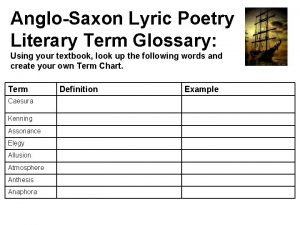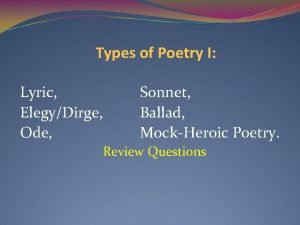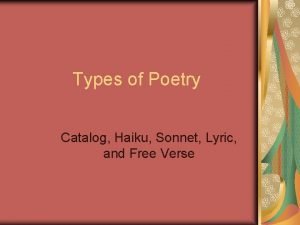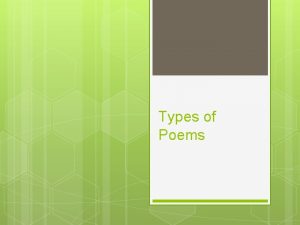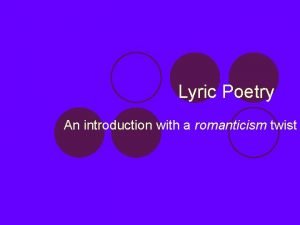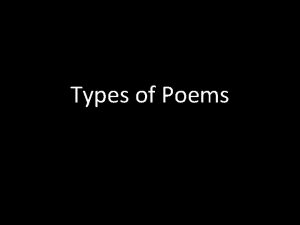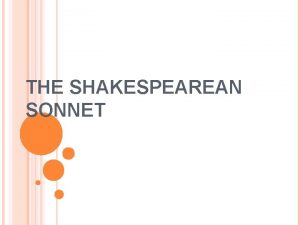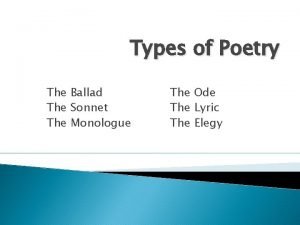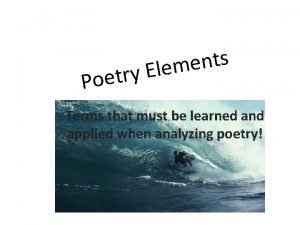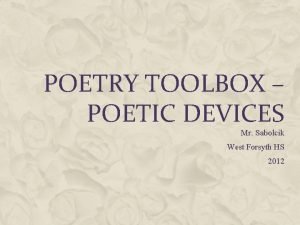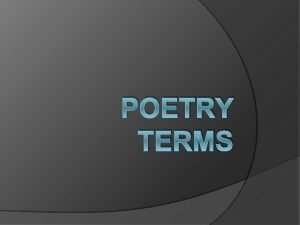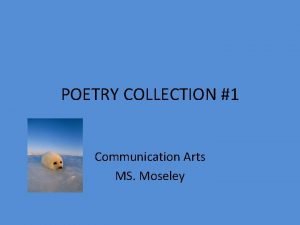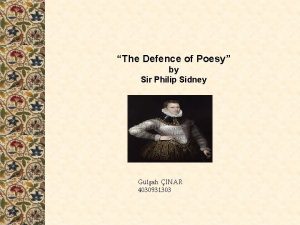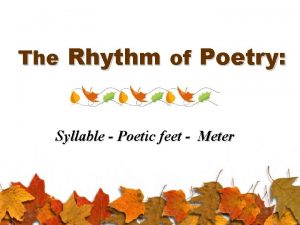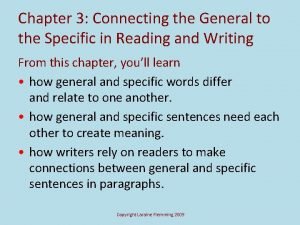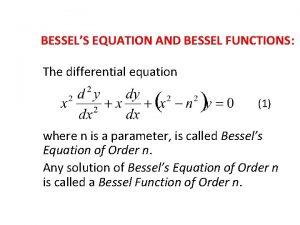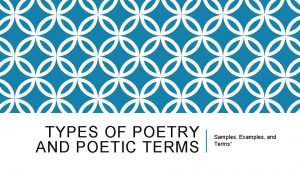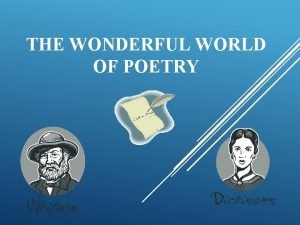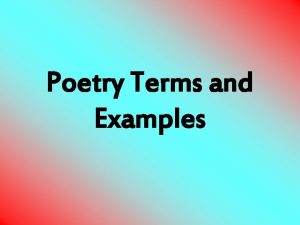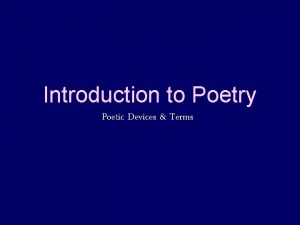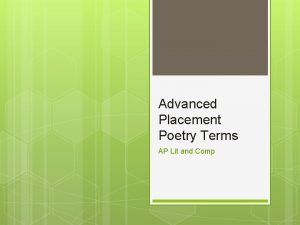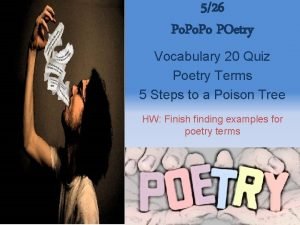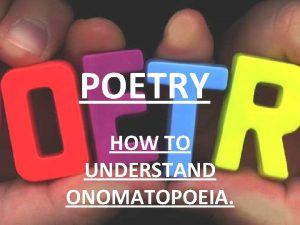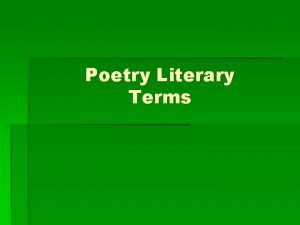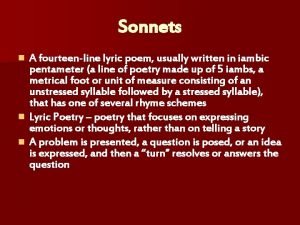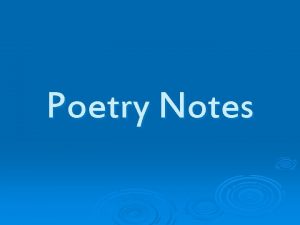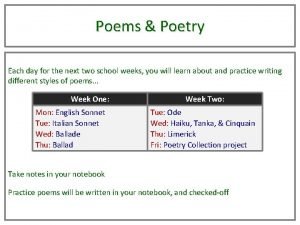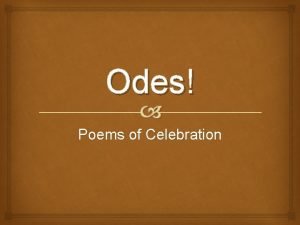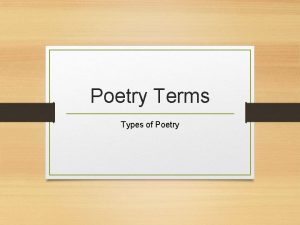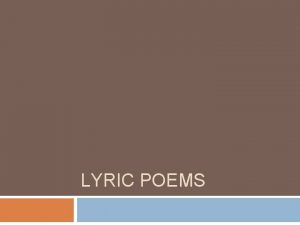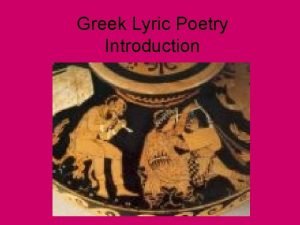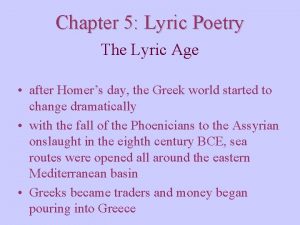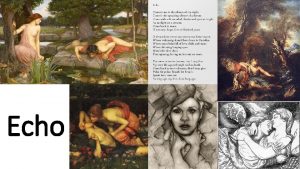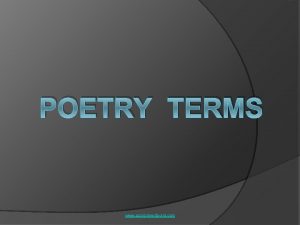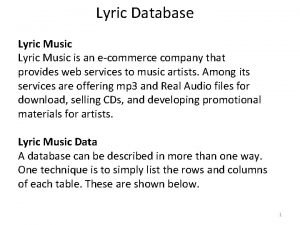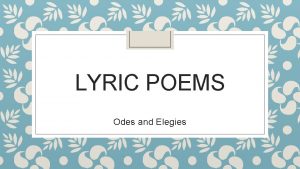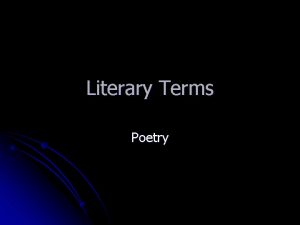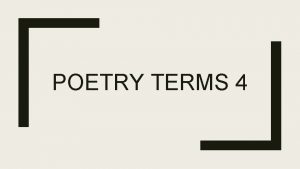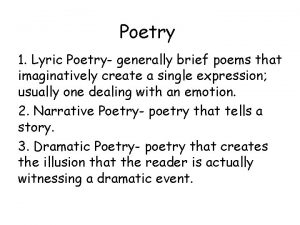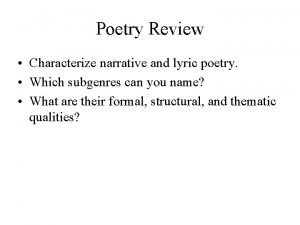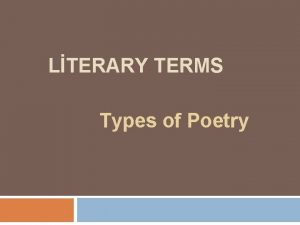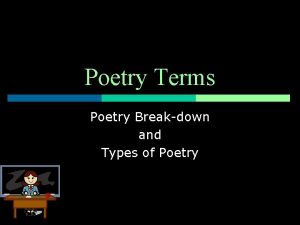Poetry Terms 2 general kinds of poetry lyric








































- Slides: 40

Poetry Terms ¬ 2 general kinds of poetry– lyric and narrative. – Lyric: originate from ancient poems sung to a lyre; includes sonnets, odes, and villanelles – Narrative are longer and were also probably chanted – The line between the two blurs in longer forms of poetry

8 Elements of Poetry ¬ 8 elements of poetry include: 1) 2) 3) 4) 5) Language Imagery Tone Rhythm & rhyme Metaphor & figurative language

8 Elements of Poetry ¬ 6. Symbols & allegory ¬ 7. Form ¬ 8. Ideas

Language ¬Discursive language depends on telling the reader something ¬Imagery is language that shows the reader something ¬Denotation=the dictionary definition

Language ¬Connotation=the meaning of a word on an emotional level ¬The poet usually controls meaning of the poem through meaning of words and sounds

Language ¬Sounds – Euphony: words that sound good together (very musical) – Cacophony: words that grate, annoy, or create distaste – Onomatopoeia: imitates the sound it refers to

Imagery ¬Images directly appeal to one of the senses: touch, sight, hearing, smell, taste ¬Imagist poets rely on creating responses through images rather than discursive language

Imagery ¬Synaesthesia refers to when an image appeals to 2 or more senses at the same time

Tone ¬Tone may be thought of as arising from the voice the poet projects. ¬They can be ironic, conversational, angry, satirical, or judgmental

Rhythm & Rhyme ¬A rhythm is a regular beat – End-stopped lines have a pause at the end of the line, usually indicated by punctuation. – Run-on lines force the reader to read beyond their end into the beginning of the next lines • Enjambment

Rhythm & Rhyme ¬Rhymed and metrical poem is called verse. – Masculine rhymes: one syllable rhymes (still, fill) – Feminine rhymes: 2 syllable rhymes (balcalava, lava)

Rhythm & Rhyme ¬Slant rhyme: sounds almost echo each other (mousse, clues) ¬Assonantal rhyme: vowels echo each other (tube, mood) ¬Consonantal rhyme: consonants echo each other (klutz, blitz)

Rhythm & Rhyme ¬Internal rhyme: end word rhymes with a word in the middle of the same line or another nearby line (turned the air, a prayer) ¬Eye rhyme: words look alike but do not sound alike (blood, food)

Meter ¬Meter is a measure of syllables into feet. ¬Iambic is the usual metrical foot in English (an unaccented syllable followed by an accented syllable)

Meter ¬ 1 foot / line = monometer ¬ 2 feet/ line= dimeter ¬ 3 feet/ line= trimeter ¬ 4 feet/ line= tetrameter ¬ 5 feet/ line= pentameter ¬ 6 feet/ line= hexameter ¬ 7 feet / line= septameter ¬ 8 feet/ line= octameter

Meter ¬Metrical foot pattern: – Iamb – Trochee – Anapest – Dactyl – Spondee U/ /U UU/ //U // in-sist pen-cil in a fix im-pli-cate top gun

Meter – Pyrrhic U U of a – Amphribrach U / U in-ter-nal – Cretic /U/ med-I-ate

Meter ¬Iamb and anapest are usually called rising rhythms because they begin with an unstressed syllable and proceed to a final stress. ¬Trochee and dactyl are, therefore, falling rhythms.

Metaphor & Figurative Language ¬Metaphor is a direct comparison between 2 unlike things ¬Figurative language includes: metaphor, oxymoron, irony, paradox, personification, pun, metonymy, synecdoche, hyperbole, and litote

Irony ¬Saying one thing and meaning another or giving an apparently innocent comparison that reveals shortcomings on the subject. ¬Verbal irony is commonly used in conversation, as when someone claims to be bad, but the reader knows the opposite is meant.

Irony ¬Dramatic Irony is not limited to words, but includes actions – Tragic irony is when the result is a tragic end to a hero

Irony ¬Cosmic irony shows fate reaching from the heavens to make an otherwise admirable person so unhappy as to cause his or her death.

Other figurative language ¬Paradox: an apparently impossible circumstance, situation, or condition. ¬Personification: giving a nonbeing the characteristics of a person.

Other figurative language ¬Pun: a play on words that usually depends on a word having several meanings or sounding like another word with a different meaning. ¬Metonymy: when you use one thing in the place of something closely related (instead of athlete using jock)

Other figurative language ¬Synecdoche: closely related to metonymy and uses part of a whole to mean the whole thing (wheels instead of car) ¬Hyperbole: overstatement for effect ¬Litotes: understatement for effect

Symbols and Allegory ¬Symbols are specialized use of words (metaphor) that is universal in nature. – Begins with a comparison but the reader is not always immediately aware that the comparison is important

Symbol & Allegory ¬Allegories are forms of symbols which are fixed (Animal Farm)

Form--Sonnets ¬All sonnets have 14 lines and usually rhyme according to one of several patterns. ¬All 14 lines are usually iambic pentameter, but are not always regular—sometimes other patterns may occur.

Form--Sonnet ¬Petrarchan Sonnet (Italian) – Divided into an octave and a sestet – The octave rhymes abba – The sestet my rhyme cdcdcd, cdecde, cdcdee, or cdedcd

Form--Sonnet ¬The normal pattern is to state the main idea in the first four lines of the octave and then to elaborate on that idea in the next 4 lines ¬Between the octave and the sestet is a turn, a change of tone, action or concept.

Form--Sonnet ¬The first part of the sestet sometimes has an example or complication of the idea developed in the octave. ¬The last 3 lines conclude the poem.

Form--Sonnet ¬Shakespearean Sonnet (English) – Divided in 3 quatrains rhyming abab, cdcd, efef and ends with a couplet gg. – The first 12 lines are elaborating an idea or a problem with details or examples.

Form--Sonnet ¬The last 2 lines resolve the issues raised by the first 3 quatrains ¬The couplet almost sounds like a tag or resoultion

Form--Ballad ¬The term “ballad” implies a song ¬Is sometimes recited to a guitar or lute ¬Traditionally tells a story, often of love, promises, war, and disappointment ¬Often depends on repetition of key lines for effect

Form--Ode ¬A long irregular poem, originally meant to be a sublime poetic utterance inspired by gods ¬Lyric in nature, exalted in tone ¬ 3 phases: strophe, antistrophe, and epode

Form--Ode ¬Odes are usually predicted on oppositions—the subject of one stanza (the antistrophe) may sometimes reevaluate the subject of the previous stanza (the strophe).

Form--Ode ¬The end of the ode (epode) usually attempts to resolve the tensions raised in the body of the ode.

Form--Villanelle ¬Not a common fixed form, lots of rhymes ¬Extremely difficult to create in English ¬ 6 stanzas with iambic pentameter: 5 with 3 lines, and the last with 4 lines

Form—Villanelle ¬There are only 2 rhymes ¬The first line and the third line of the first stanza repeat throughout the poem ¬Stanza 2 ends with line 1 ¬Stanza 3 ends with line 3

Form--Villanelle ¬Stanza 4 ends with line 1 ¬Stanza 5 ends with line 3 ¬Stanza 6 ends with lines 1 and 3
 Kinds of lyric poetry
Kinds of lyric poetry Famous lyric poetry
Famous lyric poetry A two word poetic renaming
A two word poetic renaming Is ode a lyric poem
Is ode a lyric poem Catalog poem
Catalog poem Simple ballad poems
Simple ballad poems Element of lyric poetry
Element of lyric poetry Slam poetry examples
Slam poetry examples Sonnet lyric poetry
Sonnet lyric poetry Introduction to sonnets
Introduction to sonnets It is a dignified and elaborately structured lyric poem
It is a dignified and elaborately structured lyric poem Narrative poem definition
Narrative poem definition Mr deeds poem
Mr deeds poem Romanticism poem generator
Romanticism poem generator Lyric poem
Lyric poem Polynomial classification
Polynomial classification Combining like terms lesson
Combining like terms lesson The defence of poesy summary
The defence of poesy summary Meter definition poetry
Meter definition poetry Example of sonnet poem
Example of sonnet poem A lyric poem that tells a story
A lyric poem that tells a story General and specific words
General and specific words Solution of bessel differential equation
Solution of bessel differential equation Poetry terms with examples
Poetry terms with examples What a wonderful world poetic devices
What a wonderful world poetic devices Poetry terms examples
Poetry terms examples What are the poetic devices
What are the poetic devices Repetition in poem meaning
Repetition in poem meaning Diamante a
Diamante a What is an example of a caesura?
What is an example of a caesura? Poetry vocabulary quiz
Poetry vocabulary quiz Poetry terms word search
Poetry terms word search Literary terms hyperbole
Literary terms hyperbole Diferencia entre gran plano general y plano general
Diferencia entre gran plano general y plano general Where did general lee surrender to general grant?
Where did general lee surrender to general grant? What is a 14 line lyric poem
What is a 14 line lyric poem Lyric essay example
Lyric essay example A poem with figurative language
A poem with figurative language A solemn and formal lyric poem about death
A solemn and formal lyric poem about death Examples of an ode
Examples of an ode Watermelon concrete poem
Watermelon concrete poem


